Filmmakers - Study guides, Class notes & Summaries
Looking for the best study guides, study notes and summaries about Filmmakers? On this page you'll find 173 study documents about Filmmakers.
Page 4 out of 173 results
Sort by
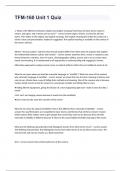
-
TFM-160 Unit 1 Quiz Questions with complete solution
- Exam (elaborations) • 9 pages • 2024
-
Available in package deal
-
- $13.99
- + learn more
TFM-160 Unit 1 Quiz Questions with complete solution TFM-160 Unit 1 Quiz 1. What is the difference between implicit and explicit meaning? (And how do these terms relate to onions, and ogres, and a movie such as Juno?" - correct answer Ogres, Onions, and movies all have layers. This relates to the implicit and explicit meaning. The implicit meaning lies below the surface of a movie's story and presentation; implied or suggested. The explicit meaning is available on the surface of the movie...
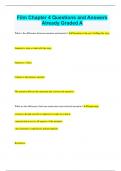
-
Film Chapter 4 Questions and Answers Already Graded A
- Exam (elaborations) • 9 pages • 2023
- Available in package deal
-
- $9.99
- + learn more
Film Chapter 4 Questions and Answers Already Graded A What is the difference between narration and narrator? Narration is the act of telling the story Narrator is who or what tells the story Narrative = Story Camera is the primary narrator The narrator delivers the narration that conveys the narrative. What are the differences between omniscient and restricted narration? Omniscient -it knows all and can tell us whatever it wants us to know -unrestricted access to all aspects of the narrativ...
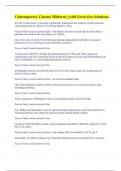
-
Contemporary Cinema Midterm || with Error-free Solutions.
- Exam (elaborations) • 5 pages • 2024
-
Available in package deal
-
- $10.19
- + learn more
In 1952, United States v. Kennerly significantly undermined the authority of local and state censorship boards by effectively reversing Mutual v. Ohio. True or False? correct answers False - The Miracle decision--named after the short film in question--was made in the case Burstyn vs. Wilson One of the ways in which New Hollywood cinema distinguished itself from its classical predecessor was a loosening of cause-and-effect narration. True or False? correct answers True As the power o...

-
ENG 225 Week 2 Quiz 2024 with complete solution; Ashford University
- Exam (elaborations) • 16 pages • 2024
- Available in package deal
-
- $15.49
- + learn more
ENG 225 Week 2 Quiz 2024 with complete solution; Ashford University Score for this attempt: 14 out of 15 Submitted Jul 19 at 8:21pm This attempt took 102 minutes. In order to truly expand and refresh a genre, a film should cut all ties with existing genre tropes. be recognizable as falling under the specified genre. develop new technologies. meet all of an audience’s expectations. Rogue One presents a different take on the science-fiction genre by stickin...

-
TFM 160 Final SDSU Voytilla with Questions and Answers
- Exam (elaborations) • 13 pages • 2024
-
Available in package deal
-
- $7.99
- + learn more
TFM 160 Final SDSU Voytilla with Questions and Answers form ANSWER the means by which the subject is expressed content ANSWER the subject of an artwork formal analysis ANSWER it dissects the complex synthesis of cinematography, sound. composition, design, movement, performance, and editing orchestrated by creative artists like screenwriters, directors, cinematographers, actors, editors, sound designers, and art directors as well as the many craftspeopple who implement their vision ci...
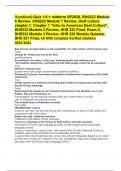
-
(Combined) Quiz 1-8 + midterm SP2020, SHS222 Module 4 Review, SHS222 Module 1 Review, Deaf culture chapter 7, Chapter 1 "Intro to American Deaf Culture", SHS222 Module 2 Review, SHS 222 Final, Exam 2, SHS222 Module 3 Review, SHS 222 Module Quizzes,
- Exam (elaborations) • 60 pages • 2023
-
- $14.49
- + learn more
(Combined) Quiz 1-8 + midterm SP2020, SHS222 Module 4 Review, SHS222 Module 1 Review, Deaf culture chapter 7, Chapter 1 "Intro to American Deaf Culture", SHS222 Module 2 Review, SHS 222 Final, Exam 2, SHS222 Module 3 Review, SHS 222 Module Quizzes, SHS 221 Final, All With Complete Verified solutions 2023/2024 Bell did not actually believe in the possibility of a deaf variety of the human race. False George W. Veditz was one of the first deaf filmmakers According to the video, in the pas...
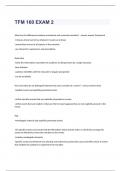
-
TFM 160 EXAM 2 questions and 100% correct answers 2024
- Exam (elaborations) • 15 pages • 2024
-
- $13.99
- + learn more
What are the differences between omniscient and restricted narration? - correct answer Omniscient -it knows all and can tell us whatever it wants us to know -unrestricted access to all aspects of the narrative -any character's experiences and perceptions Restrictive -limits the information it provides the audience to things known by a single character -Rear Window -audience identifies with the character's singular perspective -can be unreliable How (and why) do we distinguish...

-
Art Questions Unit 2 Questions and Correct Answers the Latest Update and Recommended Version
- Exam (elaborations) • 12 pages • 2024
-
- $10.49
- + learn more
When using a series of squares that are exactly the same shape, implied depth can be achieved by ________. all of these One method used to establish depth in Hokusai's "The Great Wave Off Shore at Kanagawa" involves placing shapes higher or lower on the page. This process for creating depth is called ________. relative position When objects are far away they lack contrast, detail, and sharpness of focus because of the interference of air. Artists take advantage of this whe...
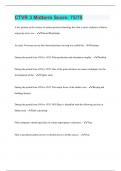
-
CTVR 3 Midterm Score: 75/75
- Exam (elaborations) • 9 pages • 2024
- Available in package deal
-
- $9.99
- + learn more
CTVR 3 Midterm Score: 75/75 A key pioneer in the science of motion picture technology that shot a series of photos of horses using trip wires was: - Edward Muybridge An early Victorian-era toy that showed pictures moving was called the: - Zoetrope During the period from 1918 to 1933: Film production and attendance roughly: - Doubled During the period from 1918 to 1933: One of the great advances in camera technique was the development of the: - Tighter shots During the period fro...
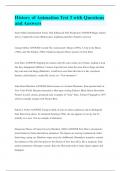
-
History of Animation Test 3 with Questions and Answers
- Exam (elaborations) • 21 pages • 2024
-
Available in package deal
-
- $7.99
- + learn more
History of Animation Test 3 with Questions and Answers Early Public Entertainment Forms That Influenced Film Production ANSWER Magic lantern shows, Vaudeville circuit (Mutoscopes, Lightning sketches, Primitive movies) George Melies ANSWER Created The Astronomer's Dream (1898), A Trip to the Moon (1902), and The Eclipse (1904). Employed special effects; pioneer of trick films. trick films ANSWER Stopping the camera, then the actor walks out of frame, making it look like they disappeared...

Study stress? For sellers on Stuvia, these are actually golden times. KA-CHING! Earn from your study resources too and start uploading now. Discover all about earning on Stuvia


